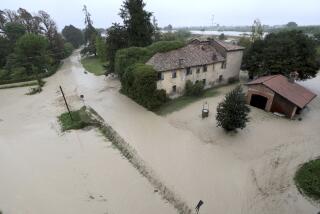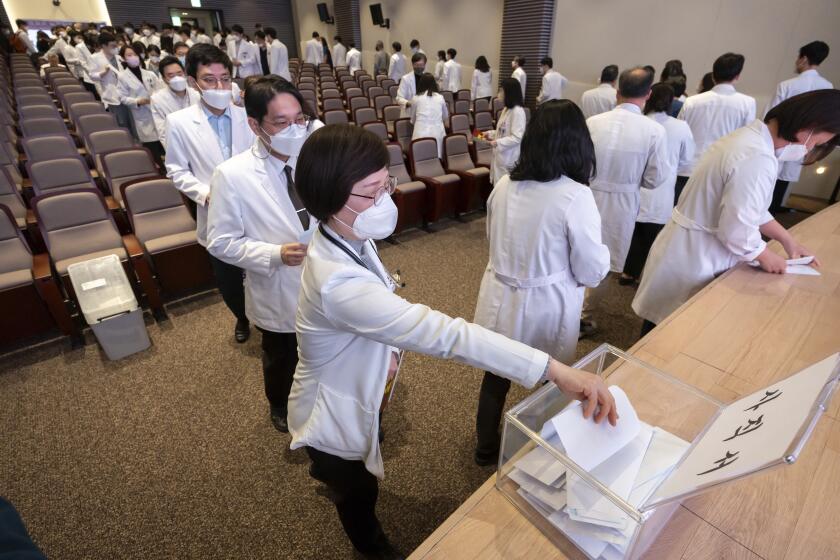Coroner Chafes at Morgue Rules
The man in charge of identifying most of those killed by Hurricane Katrina, New Orleans Coroner Frank Minyard, complained Thursday that federal regulations had unnecessarily slowed that process.
The Federal Emergency Management Agency -- which is responsible for keeping the morgue operational -- sometimes shuts it down with hours left in the workday, Minyard said. During an afternoon news conference at FEMA headquarters here, the coroner said that on Thursday, federal officials told his people to stop conducting autopsies at 11:30 a.m., despite a backlog of 300 bodies.
Minyard said he needed more pathologists to perform autopsies but FEMA would not allow its doctors to assist.
His grievances were the latest lodged against FEMA, which has been criticized for its sluggish response to Katrina and its inability to get many of the evacuees into housing.
Not being able to perform autopsies in a timely manner has been personally troubling for Minyard. A 76-year-old jazz trumpeter who has been New Orleans’ elected coroner for 30 years, he is fielding complaints from longtime friends who cannot get their loved ones’ remains out of the morgue FEMA has set up in St. Gabriel, La.
“I know most of these people are from New Orleans. I recognize their names,” said Minyard, wearing a T-shirt with the logo of a French Quarter grocery store. “These are my people, and I want to take care of them.”
Minyard and other officials in Louisiana say they are grateful FEMA has set up the morgue and is helping with the early stages of identifying corpses, but that the bureaucratic obstacles are a constant frustration.
“God bless them,” he said of the FEMA team that helps run the morgue, “but they’ve got their rules.”
Don Kelly, a spokesman for FEMA’s mortuary team, said that no one from his unit has forced autopsies to end early and that the federal personnel had tried to be helpful.
“Everybody is under difficult circumstances, and every day we do the best we can to assist the state in IDing the victims of the hurricane,” Kelly said.
A New Orleans native, Kelly said he grew up listening to Minyard’s jazz concerts. “I love Dr. Minyard,” he said. “I just appreciate the opportunity to set the record straight.”
Although the search for corpses has been called off in Louisiana, the death toll from Katrina remains unknown. State officials put the number of victims at 988 Thursday but said the total would keep rising. On Wednesday, they said, 11 families had returned to their homes and found bodies there.
Just 73 of the dead have been publicly identified, but the state says many more bodies will be released to families in coming days. About 360 are tentatively identified and need final confirmation.
The state released its first summary of Katrina’s victims Thursday but could provide little demographic information.
Of the bodies that have passed through the central morgue, 61% have not been identified well enough to know their age. Forty percent are black, and 35% are white; the race of 22% of the corpses is not clear. DNA tests to identify many of the corpses will take months, said Dr. Louis Cataldie, the top state medical examiner coordinating the Katrina death count.
Cataldie said some hurricane victims’ bodies may never be recovered.
“We feel we may have lost people into the river, we may have lost people into the marshes, we may have lost people into the gulf,” Cataldie said. “There may be no way to ever find those people.”
Most of the autopsies the state has completed are of people who died in hospitals and nursing homes, a circumstance that is the subject of a criminal investigation by the Louisiana attorney general. At least 10 victims died at the airport while waiting to be triaged and taken elsewhere, Cataldie said.
The chaos of Katrina was felt early at the New Orleans coroner’s office.
Minyard, an obstetrician-gynecologist who ran for coroner in the early 1970s on a platform of allowing methadone treatment for drug addicts, is a renowned character in the city. His band, the French Market Jazz Band, sometimes plays in jazz funerals; in 1974, he was arrested for disorderly conduct for playing his trumpet in public.
As a veteran of many hurricanes, Minyard figured he and his staff could ride out the storm and continue their work in the city morgue. They arrived there after Katrina blew through to find 10 feet of water, and they were stranded for four days before being rescued by boat.
With $7 in his pocket, the coroner hitchhiked to Baton Rouge -- where he figured a new morgue would be erected. A Jefferson Parish police officer gave him a lift. “He didn’t believe I was who I said I was,” Minyard recalled Thursday.
FEMA set up the morgue in the hamlet of St. Gabriel, just south of Baton Rouge, and Minyard began to track down his staff.
Before Katrina hit, many of his workers were holding down two jobs to make ends meet. Now, Minyard said, some are spending all their city pay buying gas to drive to the FEMA morgue dozens of miles from their new homes.
New Orleans Mayor C. Ray Nagin announced this week that the city was laying off half its work force. Minyard said he had been told to lay off those on his staff of 35 who had been unable to report for work.
On Thursday, the coroner spent the most time detailing headaches he has encountered dealing with FEMA.
At the morgue, the federal team decontaminates incoming corpses and logs identifying data such as fingerprints and dental records. But Minyard’s six pathologists must perform all autopsies on New Orleans residents, who make up most of the victims. Minyard said federal officials told him that their doctors could not help for fear of being tangled up in lawsuits.
Kelly, the FEMA spokesman, said that under state law, only New Orleans pathologists can perform the autopsies.
The condition of the bodies is so bad, Minyard said, that autopsies can only be performed in two- to three-hour shifts before the smell is overwhelming.
And lately, the coroner said, when the FEMA team has finished its work, they tell Minyard’s people that they must cease all autopsies and close the morgue. “We can’t be getting kicked out each day at noon,” he said. The state is planning to move to another morgue if that continues.
Kelly denied that has happened. “I don’t know where he came from on this.”
Communications at the morgue also have been a hassle, Minyard said.
The database there does not connect to the government database of people reported missing in the storm. Minyard’s cellphone has barely worked. And until a state official donated her phone and fax machine Wednesday, Minyard had to send a worker to a fax two blocks away.
Minyard is up for reelection in February and had been planning to retire, but that is up in the air. Asked what his plans were, he replied, “I’ll still be here.”
More to Read
Sign up for Essential California
The most important California stories and recommendations in your inbox every morning.
You may occasionally receive promotional content from the Los Angeles Times.










